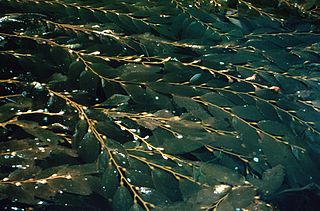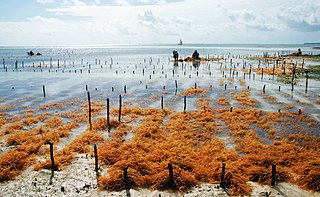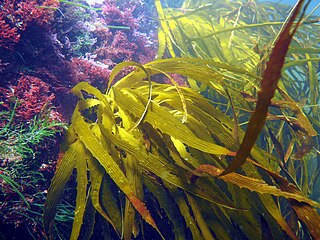
Aquaculture of giant kelp, Macrocystis pyrifera , is the cultivation of kelp for uses such as food, dietary supplements or potash. [1] [2] Giant kelp contains iodine, potassium, other minerals vitamins and carbohydrates. [3] [4]

Aquaculture of giant kelp, Macrocystis pyrifera , is the cultivation of kelp for uses such as food, dietary supplements or potash. [1] [2] Giant kelp contains iodine, potassium, other minerals vitamins and carbohydrates. [3] [4]
At the beginning of the 20th century California kelp beds were harvested for their potash. [1] [5] [6] Commercial interest increased during the 1970s and the 1980s due to the production of alginates, and also for biomass production for animal feed due to the energy crisis. [5] [6] However commercial production for M. pyrifera never developed. With the end of the energy crisis and the decline in alginate prices, research into farming Macrocystis declined. [2]
The supply of M. pyrifera for alginate production relied heavily on restoration and management of natural beds during the early 1990s. [2] [7] Other functions such as substrate stabilization were explored in California, where the “Kelp bed project” transplanted 3-6m adult specimens to increase the stability of the harbor and promote diversity. [7] [3] [8]
Research is investigating its use as feed for other aquaculture species such as fish. [7] [9]
China and Chile are the largest producers of aquatic plants and algae, each producing over 300,000 tonnes in 2007. How much of this total can be attributed to M. pyrifera is unclear. [10] Both countries culture a variety of species; in Chile 50% of the production involves Phaeophytes and the other 50% is Rhodophytes . [11] China produces a larger variety of seaweeds including chlorophytes. [12] Experiments in Chile are exploring hybrids of M. pyrifera and M. integrifolia . [13]
Kelp farming development has been ongoing in Oregon and British Columbia. [14] [15] [16] Startups have begun leasing water in Alaska to cultivate M. Pyrifera at a large scale. [17] [18]
In the 2010s, Northern California lost 95% of its kelp ecosystems due to marine heatwaves. [19] [20] [21] [22]
Kelp bed recovery efforts in California are primarily focusing on sea urchin removal, [23] both by scuba divers, and by sea otters, which are natural predators. [24] [25] [26] [27] [28]
A brown algae, Sargassum horneri , an invasive species first spotted in 2003, has also been a concern. [29] [30]
Researchers at the Bodega Marine Laboratory of UC Davis are developing replanting strategies, and volunteers of the Orange County Coastkeeper group are replanting giant kelp. [31] [32] Humboldt State University began cultivating bull kelp in its research farm in 2021. [33]
Research efforts at the state level to prevent kelp forest collapse in California were announced in July 2020. [34]
At the federal level, H.R. 4458, the Keeping Ecosystems Living and Productive (KELP) Act, introduced July 29, 2021, seeks to establish a new grant program within NOAA for kelp forest restoration. [35]
Ocean Rainforest, a Faroe Islands-based company, secured $4.5 million in U.S. government funding to grow giant kelp on an 86-acre farm off the coast of Santa Barbara, California. [36]
The most common method of cultivating M. pyrifera was developed in China in the 1950s. It is called the long line cultivation system, where the sporelings are produced in a cooled water greenhouse and then planted in the ocean attached to long lines. [37] The depth at which they are grown varies. This species alternates generations in its life cycle, cycling between a large sporophyte and a microscopic gametophyte. The sporophyte is harvested as seaweed. The mature sporophytes form the reproductive organs called sori. They are found on the underside of the leaves and produce the motile zoospores that germinate into the gametophyte. [38] [39] To induce sporulation, plants are dried for up to twelve hours and placed in a seeding container filled with seawater of about 9-10 °C; salinity of 30% and a pH of 7.8-7.9. [11] [37] [40] Photoperiod is controlled during sporulation and growth phases. A synthetic twine of about 2 – 6mm in diameter is placed on the bottom of the same container after sporulation. The released zoospores attach to the twine and begin to germinate into male and female gametophytes. [11] [37] [40] Upon maturity these gametophytes release sperm and egg cells that fuse in the water column and attach themselves to the same substrate as the gametophytes (the twine). [11] [37] [40] These plants are reared into young sporophytes for up to 60 days. [37] [40]
These strings are either wrapped around or are cut up into small pieces and attached to a larger diameter cultivation rope. The cultivation ropes vary, but extend approximately 60m with floating buoys attached. [11] The depths vary. In China, M. pyrifera is cultivated on the surface with floating buoys attached every 2-3m and the ends of the rope attached to a wooden peg anchored to the substrate. Individual ropes are usually hung at 50 cm intervals. [37] In Chile M. pyrifera is grown at a depth of 2m using buoys to keep the plants at a constant depth. [40] These are then let alone to grow until harvest.
Problems that afflict this method include management of the transition from spore to gametophyte and embryonic sporophyte which are done on a terrestrial facility with careful control of water flow, temperature, nutrients and light. [37] The Japanese use a forced cultivation method where 2 years of growth is achieved within a single growing season by controlling inputs. [37]
In China a project for offshore/deep water cultivation used various farm structures to facilitate growth, including pumping nutrients from deep water into the beds. The greatest benefit for this approach was that the algae were released from size constraints of shallow waters. Issues with operational and farm designs plagued deep water cultivation and ended further exploration. [37]
The duration of cultivation varies by region and farming intensity. This species is usually harvested after two growth seasons (2 years). [11] [37] M. pyrifera which is artificially cultivated on ropes is harvested by a pulley system that is attached to boats that pull the individual lines on the vessels for cleaning. [11] [37] Other countries such as the US rely primarily on naturally grown M. pyrifera, use boats to harvest the surface canopy several times per year. This is possible due to fast growth while the vegetative and reproductive parts are left undamaged. [3] [41]
In the UK, legislation defines giant kelp as a nuisance. Invasive specimens are mechanically removed. [42]
The demand for M. pyrifera centers on fertilizers, bioremediation and feed for abalone and sea urchins. [2] [7]
Offsetting current carbon emissions would require some 50 trillion trees. An alternative offset would be to cultivate kelp forests. Kelp can grow at 2 feet per day, 30 times faster than terrestrial plants. Planting kelp across 10% of the oceans (4.5 x the area of Australia) could provide the same offset. Additionally, the kelp would support a fish harvest of 2 megatons per year and reduce ocean acidification. Large scale open ocean forestry would require engineered substrate and added nutrients. [43] [44]
A Maine startup, Running Tide Technologies, seeks to grow large quantities of kelp which would sequester carbon in the ocean floor. [45] [46] [47] [48]
A kelp nursery and planting program is under development near Catalina Island. Cultivation techniques using a "kelp elevator" have shown promise for biofuel production using thermochemical liquefaction. [49] [50] This research effort is supported by ARPA-E. [51] [52]
Small-scale cultivation uses kelp as a replacement for kale. [49] Organizations such as Connecticut-based GreenWave connect ocean farmers with kelp buyers in an effort to support the ocean greens market.

Mariculture, sometimes called marine farming or marine aquaculture, is a branch of aquaculture involving the cultivation of marine organisms for food and other animal products, in seawater. Subsets of it include, fish farms built on littoral waters, or in artificial tanks, ponds or raceways which are filled with seawater. An example of the latter is the farming of plankton and seaweed, shellfish like shrimp or oysters, and marine finfish, in saltwater ponds. Non-food products produced by mariculture include: fish meal, nutrient agar, jewellery, and cosmetics.

Kelps are large brown algae or seaweeds that make up the order Laminariales. There are about 30 different genera. Despite its appearance, kelp is not a plant but a stramenopile, a group containing many protists.

Brown algae are a large group of multicellular algae comprising the class Phaeophyceae. They include many seaweeds located in colder waters of the Northern Hemisphere. Brown algae are the major seaweeds of the temperate and polar regions. Many brown algae, such as members of the order Fucales, commonly grow along rocky seashores. Most brown algae live in marine environments, where they play an important role both as food and as a potential habitat. For instance, Macrocystis, a kelp of the order Laminariales, may reach 60 m (200 ft) in length and forms prominent underwater kelp forests that contain a high level of biodiversity. Another example is Sargassum, which creates unique floating mats of seaweed in the tropical waters of the Sargasso Sea that serve as the habitats for many species. Some members of the class, such as kelps, are used by humans as food.

Kelp forests are underwater areas with a high density of kelp, which covers a large part of the world's coastlines. Smaller areas of anchored kelp are called kelp beds. They are recognized as one of the most productive and dynamic ecosystems on Earth. Although algal kelp forest combined with coral reefs only cover 0.1% of Earth's total surface, they account for 0.9% of global primary productivity. Kelp forests occur worldwide throughout temperate and polar coastal oceans. In 2007, kelp forests were also discovered in tropical waters near Ecuador.

Nereocystis is a monotypic genus of subtidal kelp containing the species Nereocystis luetkeana. Some English names include edible kelp, bull kelp, bullwhip kelp, ribbon kelp, bladder wrack, and variations of these names. Due to the English name, bull kelp can be confused with southern bull kelps, which are found in the Southern Hemisphere. Nereocystis luetkeana forms thick beds on subtidal rocks, and is an important part of kelp forests.

Laminaria is a genus of brown seaweed in the order Laminariales (kelp), comprising 31 species native to the north Atlantic and northern Pacific Oceans. This economically important genus is characterized by long, leathery laminae and relatively large size. Some species are called Devil's apron, due to their shape, or sea colander, due to the perforations present on the lamina. Others are referred to as tangle. Laminaria form a habitat for many fish and invertebrates.

Macrocystis is a monospecific genus of kelp with all species now synonymous with Macrocystis pyrifera. It is commonly known as giant kelp or bladder kelp. This genus contains the largest of all the Phaeophyceae or brown algae. Macrocystis has pneumatocysts at the base of its blades. Sporophytes are perennial and the individual may live for up to three years; stipes/fronds within a whole individual undergo senescence, where each frond may persist for approximately 100 days. The genus is found widely in subtropical, temperate, and sub-Antarctic oceans of the Southern Hemisphere and in the northeast Pacific. Macrocystis is often a major component of temperate kelp forests.

Algaculture is a form of aquaculture involving the farming of species of algae.

Lessonia is a genus of large kelp native to the southern Pacific Ocean. It is restricted to the southern hemisphere and is distributed along the coasts of South America, New Zealand, Tasmania, and the Antarctic islands. Lessonia is one of two principal genera in kelp forests.

Integrated multi-trophic aquaculture (IMTA) is a type of aquaculture where the byproducts, including waste, from one aquatic species are used as inputs for another. Farmers combine fed aquaculture with inorganic extractive and organic extractive aquaculture to create balanced systems for environment remediation (biomitigation), economic stability and social acceptability.

Alaria is a genus of brown alga (Phaeophyceae) comprising approximately 17 species. Members of the genus are dried and eaten as a food in Western Europe, China, Korea, Japan, and South America. Distribution of the genus is a marker for climate change, as it relates to oceanic temperatures.
Gelidium is a genus of thalloid red algae comprising 134 species. Its members are known by a number of common names.

Seaweed, or macroalgae, refers to thousands of species of macroscopic, multicellular, marine algae. The term includes some types of Rhodophyta (red), Phaeophyta (brown) and Chlorophyta (green) macroalgae. Seaweed species such as kelps provide essential nursery habitat for fisheries and other marine species and thus protect food sources; other species, such as planktonic algae, play a vital role in capturing carbon and producing at least 50% of Earth's oxygen.

Seaweed farming or kelp farming is the practice of cultivating and harvesting seaweed. In its simplest form farmers gather from natural beds, while at the other extreme farmers fully control the crop's life cycle.

Pterygophora californica is a large species of kelp, commonly known as stalked kelp. It is the only species in its genus Pterygophora. It grows in shallow water on the Pacific coast of North America where it forms part of a biodiverse community in a "kelp forest". It is sometimes also referred to as woody-stemmed kelp, walking kelp, or winged kelp.

Eucheuma, commonly known as sea moss or gusô, is a rhodophyte seaweed that may vary in color. Eucheuma species are used in the production of carrageenan, an ingredient for cosmetics, food processing, and industrial manufacturing, as well as a food source for people in the Philippines, Caribbean and parts of Indonesia and Malaysia. Eucheuma cottonii – which grows in the Caribbean and cultivated in the Philippines – is the particular species known as gusô. Other species include Betaphycus gelatinae, Eucheuma denticulatum, and several species of the genus Kappaphycus, including K. alvarezii. Since the mid-1970s, Kappaphycus and Eucheuma have been a major source for the expansion of the carrageenan industry.
Sunamphitoe femorata is a species of amphipod crustacean in the family Ampithoidae. It is a herbivore and constructs a tubular nest-like home on a blade of the sporophyte of the giant kelp Macrocystis pyrifera. This home is made by rolling the sides of the blade together and securing them with silk. As the kelp blade grows, the nest is advanced down the blade towards the base, approximately keeping pace with the algal growth.
Lessonia trabeculata is a species of kelp, a brown alga in the genus Lessonia. It grows subtidally off the coasts of Peru and northern and central Chile, with the closely related Lessonia nigrescens tending to form a separate zone intertidally. Lessonia trabeculata kelp have gained a great economic importance for alginate production, and its harvest has greatly intensified along the Chilean coast during past two decades

Maullinia is a genus of intracellular, phytomyxid parasites found across the Southern Hemisphere though primarily in Chile, The Prince Edward Islands, South Africa, Australia, and New Zealand. These parasites infiltrate the cells of their brown algal hosts via cytoplasmic extensions called plasmodia that divide synchronously, becoming increasingly multi-nucleate and engulfing the host cell organelles as they grow. Eventually, as the plasmodia fill the entire cell volume, the host cells become hypertrophied and grow to 3- 4x their original size, showing up as swollen appendages or galls on the host tissue at a macroscopic level. These swollen regions will burst alongside the mature Maullinia plasmodia, releasing biflagellated zoospores to the inter- and extracellular space to disperse the infection further. Zoospores can come from sporangial plasmodia, as in M. ectocarpii, or from resting spores, as in M. braseltonii.

Lessonia corrugata is a species of kelp, a brown algae in the genus Lessonia, commonly known as strapweed, common crapweed, or Tasmanian kombu. It is a subtidal species endemic to Tasmania and southern Victoria, Australia, and is the least studied of the only three Laminarian kelps in the region. The species was first described by Arthur Henry Shakespeare Lucas in 1931, and is most closely related to the New Zealand species Lessonia variegata.